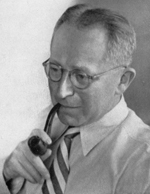This article needs additional citations for verification. (February 2022) |
Adriaan van Maanen | |
|---|---|
 | |
| Born | March 31, 1884 Sneek, Netherlands |
| Died | January 26, 1946 (aged 61) Pasadena, California, United States |
| Alma mater | University of Utrecht |
| Known for | Van Maanen's star |
| Scientific career | |
| Fields | Astronomy |
| Institutions | |
| Doctoral advisor | Albertus Antonie Nijland |
Adriaan van Maanen (March 31, 1884 – January 26, 1946)[1] was a Dutch-American astronomer. Born in Friesland, he studied astronomy at the University of Utrecht, earning his Ph.D. in 1911, and worked briefly at the University of Groningen. In 1911, he came to the United States to work as a volunteer in an unpaid capacity at Yerkes Observatory. Within a year he got a position at the Mount Wilson Observatory, where he remained active until his death in 1946.
Van Maanen claimed that his astrometric measurements of spiral nebulae revealed detectable internal motions, supporting the idea that these nebulae were local, stellar and gaseous systems that existed in our galaxy. His measurements were not consistent with Edwin Hubble's discovery that the Andromeda Nebula and other spiral nebulae were extragalactic objects. The speed of rotation he calculated for the nebulae, if Hubble were correct as to their extragalactic nature, would have had their Cepheid stars moving at speeds faster than that of light. Van Maanen's astrometric measurements were subsequently found to be in error.
In 1924, van Maanen became member of the Royal Netherlands Academy of Arts and Sciences.[2]
- ^ Seares, Frederick H. (April 1946). "Adriaan van Maanen, 1884-1946". Publications of the Astronomical Society of the Pacific. 58 (341): 89–103. Bibcode:1946PASP...58...89S. doi:10.1086/125791. ISSN 0004-6280. JSTOR 40671760. S2CID 122629369.
- ^ "A. van Maanen (1884 - 1946)". Royal Netherlands Academy of Arts and Sciences. Retrieved 17 July 2015.